Demystifying Shred: How to Achieve Maximum Speed with Minimal Effort
Bolster your chops and articulate fast runs by using economy picking.

*** Before you start, we recommend bookmarking this page for easy return ***
As a teenager, during the “bedroom practice rat” phase of my musical development, I pored obsessively over videos of my favorite electric guitar players, hoping to glean any tips that would help me achieve their level of musical and technical mastery.
Watching the likes of Steve Vai or Eric Johnson glide through complex phrases at breakneck speeds was both inspiring and mystifying. The most beguiling element of their playing was their picking technique.
While I observed that much of their phrasing was rooted in alternate (down-up) picking, some phrases seemed to involve less picking, even though they sounded as if they were picked faster. This made me wonder: How are these guys picking so fast while looking like they’re barely picking at all? The answer, as it turns out, was that they were employing a useful technique commonly referred to as economy picking.
Used for playing single-note lines, economy picking combines alternate picking and sweep picking. Alternate picking is used when playing consecutive notes on the same string, but when crossing to the next higher or lower string, a mini two-note sweep – down-down, or up-up – is employed. Economy picking utilizes efficiency of motion – the minimal movement principle – and produces a relatively smooth note attack, compared to the more defined, “popping” articulation of alternate picking.

Alternate picking requires the most back-and-forth motion in the picking hand, whereas the mini-sweep transitions from string-to-string in economy picking require less movement overall while still enabling you to pick the same number of notes.
In this lesson, I’ll show you how to use economy picking to add new technical capabilities and phrasing options to your lead playing. Let’s begin by breaking down the mechanics of economy picking.
Three-Notes-Per-String Phrasing
Economy picking is most commonly used for performing scale- and mode-based melodic picking runs with three notes on each string in a given fretboard position. This is due to the fact that these odd-numbered note groupings result in the first and third pick strokes matching when using alternate picking.
For example, when ascending, the pattern will be down-up-down on one string. Then, instead of continuing to alternate pick when you cross to the next higher string, with an upstroke, you instead simply sweep into it with a continuation of the previous downstroke, which begins another down-up-down sequence on the higher string. The longer repeating pattern then becomes down-up-down, down-up-down, etc.
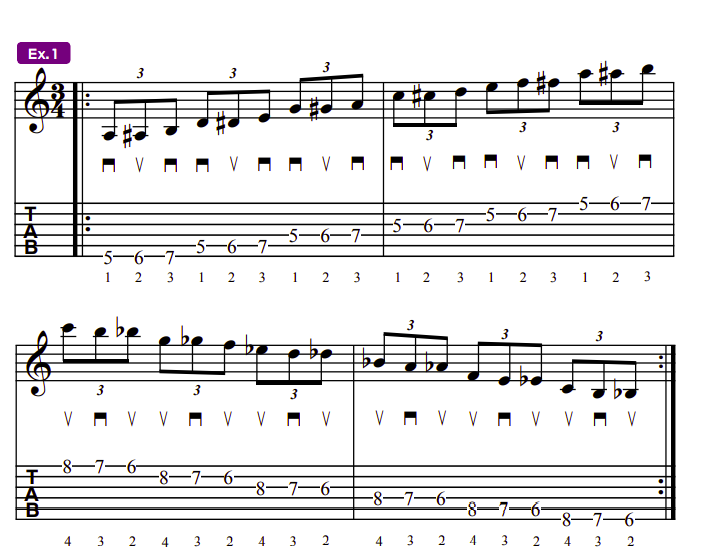
The opposite approach may be employed to play a descending scalar or modal run and crossing to a lower string: up-down-up, up-down-up, etc. Ex. 1 is a simple, three-notes-per-string chromatic exercise that utilizes a symmetrical fretboard pattern (to enable you to focus more on your pick hand), for which you will ascend, then descend across all six strings in fifth position, using the same compact shape on each string.
When ascending, pick down-up-down on each string, sweeping down when crossing to the next higher string. Then, when you descend, switch to up-down-up, up-down-up, etc., sweeping up when crossing to the next lower string.
To transition smoothly from one string to the next, you may rest your pick on the new string after picking the third and final note on the previous string. This is commonly referred to as a rest stroke. Applying rest strokes to economy picking is a technique often referred to as gypsy picking, named for gypsy jazz guitarists like Django Reinhardt, who first popularized the technique. This will prevent you from “hopping” your pick from string to string, and make each transition as smooth and efficient as possible.
While the even, familiar meter of alternate picking may feel intuitive, the sweep transitions may initially throw you off your rhythm and sense of timing, so be sure to practice this and all of the following exercises slowly at first and with a metronome, while tapping your foot on each downbeat to ensure rhythmic accuracy and acquire the proper, desired muscle memory.
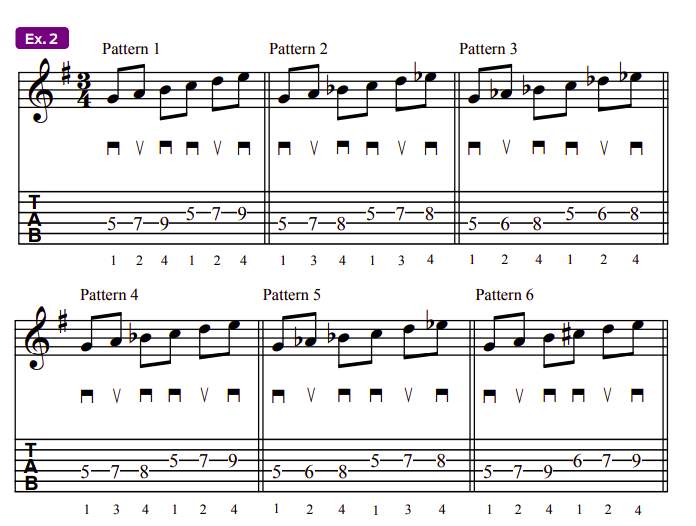
Now let’s look at some melodic patterns that are commonly featured in economy-picking licks and runs. Ex. 2 shows a series of two-string, six-note scale fragments and fretboard shapes that are found throughout the modes of the major scale. Each fragment begins on the note G, on the fifth fret of the D string. Playing each scale fragment from the same starting note will help you familiarize yourself with and compare the various shapes.
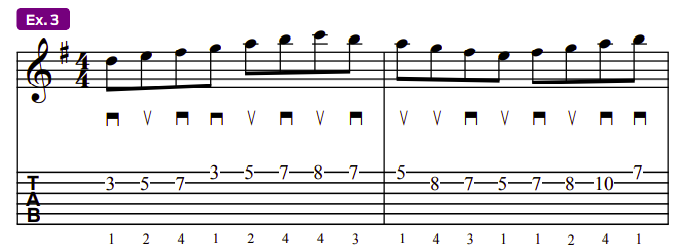
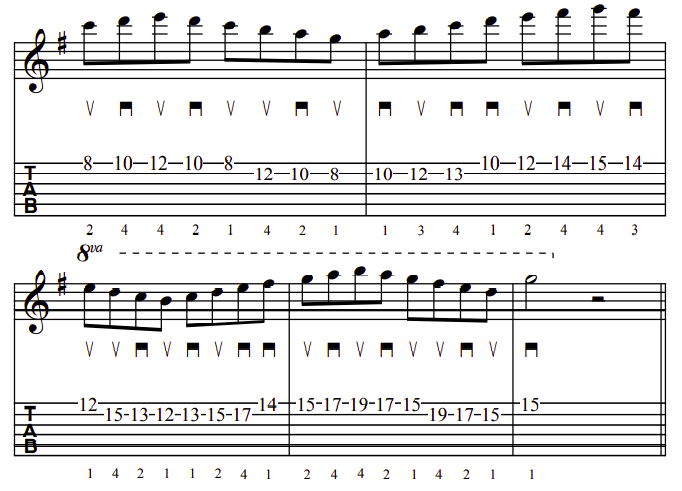
Ex. 3 arranges these scale fragments in ascending order, moving up the fretboard through the G major scale (G A B C D E F# G) on the top two strings. Starting on D, the fifth degree of the scale, located on the B string’s third fret, you will ascend Pattern 1 from the previous example, using a down-up-down, down-up-down picking sequence to play the first six notes across the two strings.
After you play the final note in the sequence – the high B on the E string’s seventh fret – shift up one fret to C and descend Pattern 2, picking up-down-up, up-down-up as you cross back over to the B string. Continue ascending then descending in this manner through each of the remaining six-note scale fragments while gradually moving up the fretboard. The result is an extended ascending economy picking lick reminiscent of shred gods like Eddie Van Halen and Steve Vai.
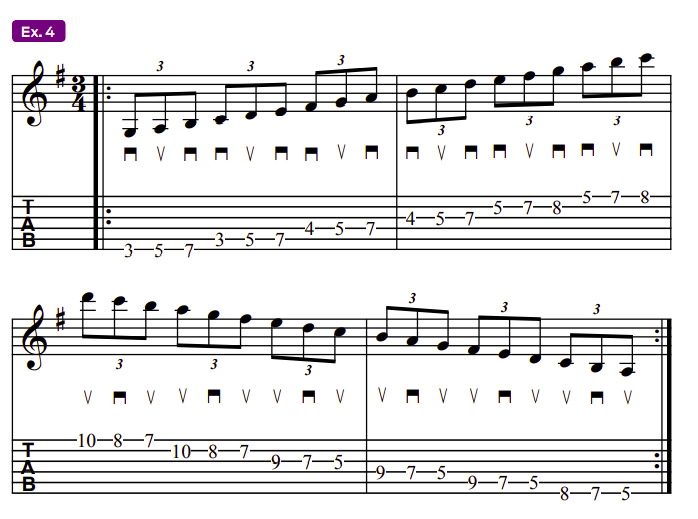
Let’s now explore how economy picking works when moving through a scale across all six strings. Ex. 4 shows an ascending and descending G major scale (also known as the G Ionian mode) run spanning over two octaves in a three-notes-per-string formation, starting on the low G root note at the third fret on the bottom string.
Employ the repeating down-up-down, down-up-down picking pattern as you ascend the scale, working your way across all six strings until you reach the high C note on the top string’s eighth fret. Then, shift up to the 10th fret with your pinkie and begin descending the G major scale’s second mode, A Dorian (A B C D E F# G), using the repeating up-down-up, up-down-up picking pattern until you get to the low A note at the fifth fret on the bottom string. After you pick that note, shift back down to G and repeat the entire sequence.
Once you feel you have mastered it, try adapting it and applying it to other pairs of consecutive modes, such as Lydian and Mixolydian, or Aeolian and Locrian. If you’re feeling really ambitious, try tackling all seven modes of the major scale in alternating ascending and descending patterns.
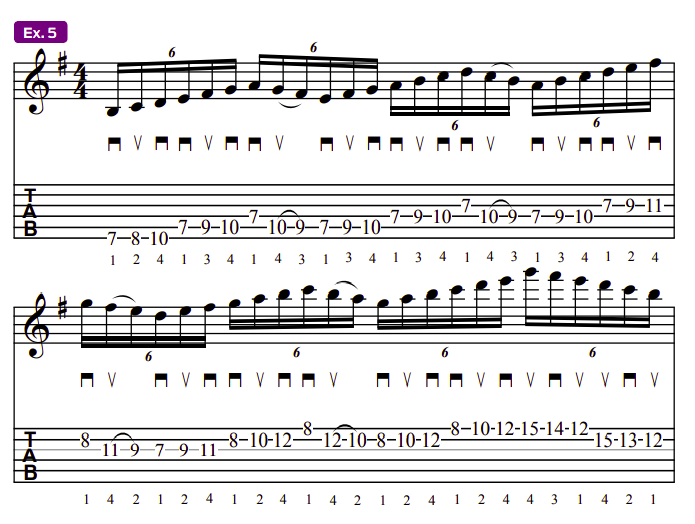
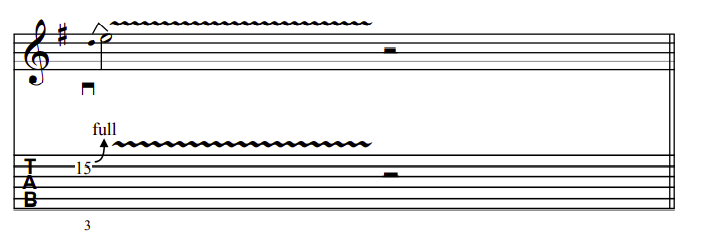
Ex. 5 has you playing a series of repeating scale patterns based on the E natural minor scale, also known as the E Aeolian mode (E F# G A B C D E), starting on the B note at the seventh fret on the low E string. From there, you’ll ascend the scale using the repeating down-up-down, down-up-down picking sequence through Pattern 5 (see Ex. 2) until reaching the A note at the seventh fret on the D string. You’ll then backtrack down the A string, playing G and F# at the 10th and ninth frets, upstroking on G and pulling off to F# .
After that, repeat the nine-note sequence, this time starting on E on the A string’s seventh fret, and so on from each successive string until beat three of bar 2. At this point, you’ll be starting the sequence from the B string, on G at the eighth fret. From there, ascend through Pattern 1 across the top two strings. Upon reaching the high E at the 12th fret, quickly shift your pinkie (finger 4) up to G at the 15th fret, then descend Pattern 5. The run concludes with a whole-step bend from D to E on the B string’s 15th fret.
Mixing Picking Techniques
Part of the challenge of employing economy picking lies in transitioning between it and other picking techniques. Since economy picking itself is a hybrid of alternate and sweep picking, it’s all too easy to inadvertently trip yourself up when switching from economy picking to straight alternate or sweep picking.
Let’s now take a look at some exercises that mix these different techniques. Ex. 6 is an ’80s shred-style run that weaves through the E natural minor scale using both economy and alternate picking. Start by alternate-picking the first six notes of bar 1 on the high E string, as indicated. From that final upstroke, keep the pick moving in an upward sweep toward the B string and descend the scale using the repeating up-down-up, up-down-up sequence, through to the D string. From there, switch back to alternate picking through the first two beats of bar 2. Similar to bar 1, you’ll finish out beat two of bar 2 on an upstroke.
Next, descend the A string, up-down-up, then sweep up to cross to the low E string, using another up-down-up sequence. Next, sweep down across the low E and A strings before finishing the run on the 12th-fret E root note, picked with an upstroke. Practice the entire two-bar exercise slowly at first, both to make sure each stroke is correct and to pinpoint and eliminate any extraneous, wasted movement.
Remember, economy picking is all about efficiency, so keep each pick stroke tight and even.
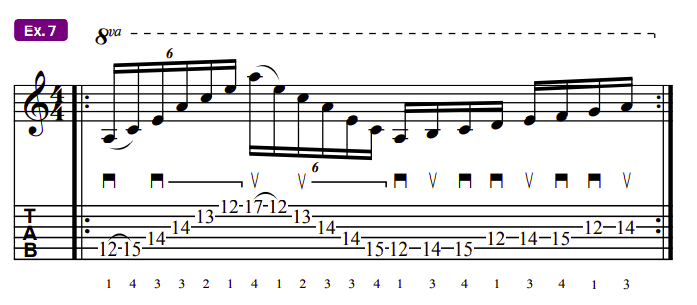
Now let’s look at economy picking paired with sweeping. Ex. 7 begins with an Am (A C E) arpeggio sweep across five strings, starting at the 12th fret on the fifth string. From there you’ll hammer-on to C at the 15th fret, then perform a downstroke sweep through the ascending arpeggio until you get to the high E at the 12th fret. Then, reach up with your pinkie to fret A at the 17th fret, picked with an upstroke, and pull off back to E. Sweep up as you descend the arpeggio back to C at the 15th fret of the A string.
This is the point where you’ll switch to economy picking.
Ascend Pattern 2 (see Ex. 2) using the repeating down-up-down, down-up-down sequence. Pick the final two notes of the exercise, on the G string, using a downstroke followed by an upstroke, then repeat the entire pattern. Since the sweep arpeggios and the economy picking line are rhythmically different – the sweeps on beats one and two are played in a sextuplet rhythm (six notes per beat), and the economy-picked notes on beats three and four are played as straight 16th notes – take care when “switching gears,” both technically and rhythmically. To help ensure accuracy, be sure to use a metronome and tap your foot as you play.
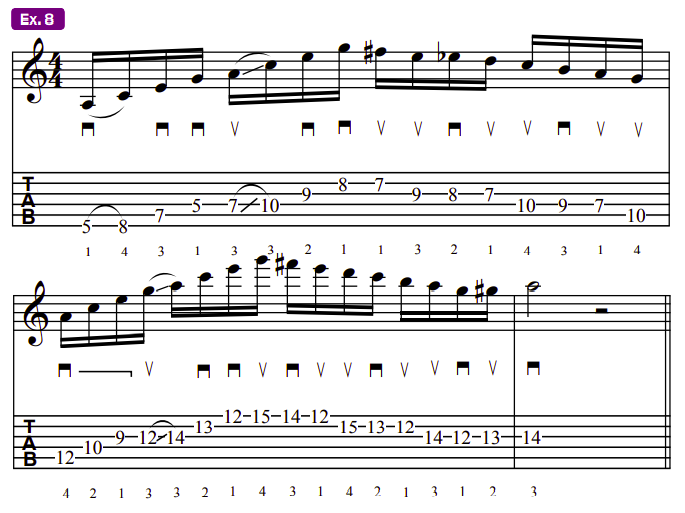
Ex. 8 begins with two ascending three-string sweeps across an Am7 arpeggio (A C E G), connected by a legato finger slide. The first arpeggio begins on A on the low E string’s fifth fret and slides into another sweep beginning in eighth position. Upon finishing the second arpeggio sweep, you’ll use economy picking to descend the A Dorian mode with the flatted fifth (b5) added, the Eb note at the eighth fret on the G string, which lends the line a slick, jazzy sound.
You’ll start descending from G on the B string’s eighth fret and use the repeating up-down-up, up-down-up sequence across the third and fourth strings until landing on G at the 10th fret on the A string. From there, proceed through two more Am7 arpeggio sweeps in higher positions, this time starting from A on the 12th fret of the fifth string.
At the peak of the second arpeggio, on the high G note at the 15th fret on the top string, you’ll once again use the repeating down-up-down, down-up-down economy picking sequence as you descend the A Dorian mode from that note down to G on the 12th fret of the third string.
Finish the run with a short chromatic ascent, from G to G# to A. Pay close attention to string transitions when moving from the sweep arpeggios to the scalar economy picking lines in this example, and try to utilize the momentum from the sweeping motions to keep your pick hand on track when switching picking techniques.
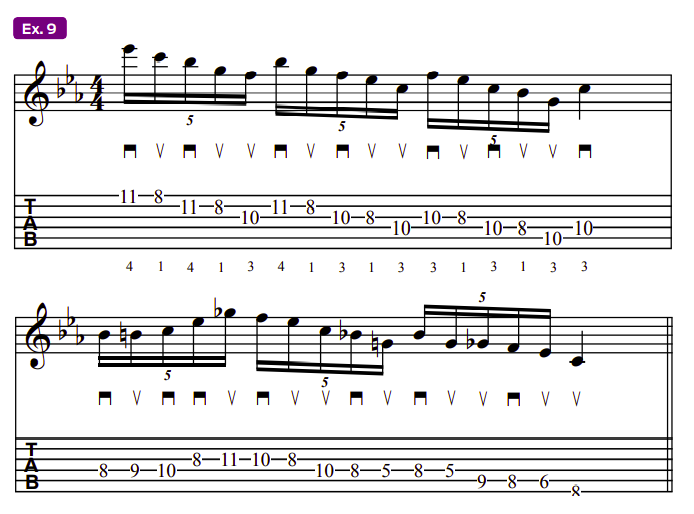
Our final example is inspired by Eric Johnson’s brilliant lead playing and use of economy picking when applied to the minor pentatonic and blues scales. Ex. 9 emulates his use of odd-numbered rhythmic subdivisions and note groupings and economical phrasing over a descending C minor pentatonic scale (C Eb F G Bb), through bar 1.
Starting on Eb, on the 11th fret of the high E string, you’ll descend the scale in quintuplets, or “fivelets,” meaning five evenly spaced notes played within the space of one beat. The first sequence will be Eb C Bb G F. Since the first four notes are played two-notes-per-string, in keeping with the standard pentatonic “box” pattern, you’ll alternate pick down-up-down-up.
Economy picking comes into play on the fifth note of each five-note group. After the upstroke on the fourth note of each phrase, sweep up into the fifth note, which falls on the next lower string. The full five-note picking sequence then becomes down-up-down-up-up. You’ll play three of these sequences, then jump back up to the C root note on the D string’s 10th fret.
In bar 2, you switch to a note pattern based on the C blues scale (C Eb F Gb G Bb), while still retaining the fivelet rhythmic structure. While the picking pattern for each fivelet in bar 1 is consistent, the patterns in bar 2 change, depending on the phrasing, so everything becomes a little more challenging as the exercise progresses. If you have difficulty counting fivelets or feeling where they land as you play, try subdividing each grouping; instead of thinking “1-2-3-4- 5,” think of them as smaller groupings of 2 + 3, or 3 + 2. This would make the count for each grouping “1-2,1-2- 3” or “1-2-3, 1-2,” with no pauses. Use whichever counting method works best for any given note and picking pattern. Be sure to accent the first note of each fivelet to help you keep track of where the downbeats land throughout.
Incorporating economy picking into your technical vocabulary will not only help you refine and expand upon other techniques, it will also help you forge new inroads into melodic phrasing.
Good luck, and have fun!
Get The Pick Newsletter
All the latest guitar news, interviews, lessons, reviews, deals and more, direct to your inbox!
“Write for five minutes a day. I mean, who can’t manage that?” Mike Stern's top five guitar tips include one simple fix to help you develop your personal guitar style
"It’s like you’re making a statement. And you never know where it’ll lead." Pete Thorn shares the tip that convinced Joe Satriani he was the right guitarist for the SatchVai Band










